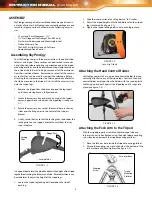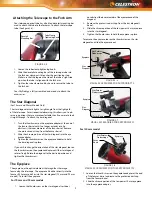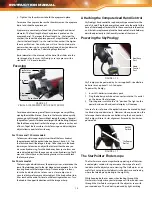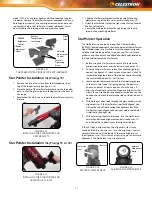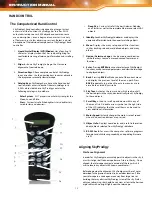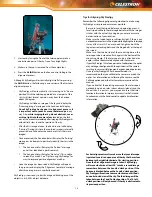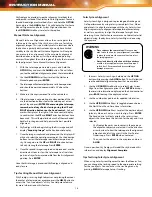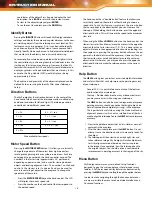
CELESTIaL OBSERVINg
With your telescope set up, you are ready to use it for observing.
This section covers visual observing hints for both solar system
and deep sky objects as well as general observing conditions
which will affect your ability to observe.
Observing the Moon
Often, it is tempting to look at the Moon when it is full. At this
time, the face we see is fully illuminated and its light can be
overpowering. In addition, little or no contrast can be seen
during this phase.
One of the best times to observe the Moon is during its partial
phases (around the time of first or third quarter). Long shadows
reveal a great amount of detail on the lunar surface. At low
power you will be able to see most of the lunar disk at one time.
Change to higher power (magnification) to focus in on a smaller
area. Choose the lunar tracking rate from the SkyProdigy’s
MENU tracking rate options to keep the Moon centered in the
eyepiece even at high magnifications.
Lunar Observing Hints
• To increase contrast and bring out detail on the lunar surface,
use eyepiece filters. A yellow filter works well at improving
contrast while a neutral density or polarizing filter will reduce
overall surface brightness and glare.
Observing the Planets
Other fascinating targets include the five naked eye planets. You
can see Venus go through its lunar-like phases. Mars can reveal
a host of surface detail and one, if not both, of its polar caps. You
will be able to see the cloud belts of Jupiter and the Great Red
Spot (if it is visible at the time you are observing). In addition,
you will also be able to see the moons of Jupiter as they orbit the
giant planet. Saturn, with its beautiful rings, is easily visible at
moderate power.
Planetary Observing Hints
• Remember that atmospheric conditions are usually the
limiting factor on how much planetary detail will be visible. So,
avoid observing the planets when they are low on the horizon
or when they are directly over a source of radiating heat,
such as a rooftop or chimney. Refer to the “Seeing Conditions”
later in this section.
• To increase contrast and bring out planetary surface detail,
try using Celestron eyepiece filters.
Observing the Sun
Although overlooked by many amateur astronomers, solar
observation is both rewarding and fun. However, because the
Sun is so bright, special precautions must be taken when observing
our nearest star so as not to damage your eyes or your telescope.
Never project an image of the Sun through the telescope.
Tremendous heat build-up may result inside the optical tube.
This can damage the telescope and/or any accessories attached
to the telescope.
For safe solar viewing, use a Celestron solar filter (see Optional
Accessories section of manual) that reduces the intensity of the
Sun’s light, making it safe to view. With a filter you can see
sunspots as they move across the solar disk and faculae, which
are bright patches seen near the Sun’s edge.
Solar Observing Hints
• The best time to observe the Sun is in the early morning or
late afternoon when the air is cooler.
• To center the Sun without looking into the eyepiece, watch
the shadow of the telescope tube until it forms a circular
shadow.
• To ensure accurate tracking on the Sun, be sure to select
solar tracking rate.
Observing Deep Sky Objects
Deep sky objects are simply those objects outside the boundaries of
our solar system. They include star clusters, planetary nebulae,
diffuse nebulae, double stars and other galaxies outside our
own Milky Way. Most deep sky objects have a large angular size.
Therefore, low-to-moderate power is all you need to see them.
Visually, they are too faint to reveal any of the color seen in long
exposure photographs. Instead, they appear black and white.
And, because of their low surface brightness, they should be
observed from a dark sky location. Light pollution around large
22
INSTRUCTION MANUAL

